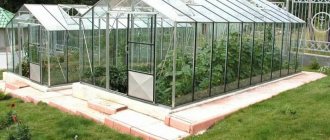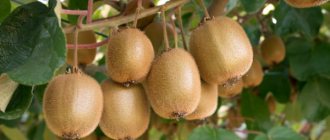Author: Elena N. https://floristics.info/ru/index.php?option=com_contact&view=contact&id=19 Category: Garden plants Published: January 27, 2019Last edits: January 13, 2021
- Planting tubers
- Anemone blanda
Anemone, like all proud beauties, requires special treatment. Therefore, no general recommendations, no universal advice! Almost each of the 160 (!) varieties of anemone has its own requirements for watering, soil, light... But don’t rush to give up whims! A certain formula for success in growing anemones (even if you don’t know the variety exactly!) still exists: plant in partial shade, organize drainage, as they grow, fertilize and loosen – half the battle is done!
- Why is the anemone afraid of weeding?
- How to organize continuous flowering of anemone on your site from April to November?
- How to wake up “lazy” flower seeds?
- How to organize proper wintering for a plant?
Read about all this in our article.
Planting and caring for anemones
- Planting: sowing fresh seeds for seedlings in June-July or before winter (October-November) in boxes. Planting tubers in spring.
- Flowering: spring, summer or autumn - depending on the species.
- Lighting: for forest species - partial shade, for Mediterranean species - bright sunlight.
- Soil: loose, fertile, (sandy or peat), preferably neutral.
- Watering: only in dry times and during the flowering period.
- Fertilizing: liquid organic and mineral fertilizers during the flowering period and in autumn.
- Reproduction: seed and vegetative (tubers, dividing the bush or parts of the rhizome).
- Pests: Leaf nematodes, aphids, South American leaf miners, thrips and whiteflies.
- Diseases: gray rot, peronosporosis (downy mildew), anthracnose, sclerotinia, viral infections.
Read more about growing anemones below.
The name of the plant anemone (lat. Anemone) , or anemone from Greek, is literally translated as “daughter of the winds,” since anemone flowers react by fluttering their petals even to the weakest gust of wind. The flower belongs to the buttercup family and is a perennial herbaceous plant. It is found in temperate climates on the plains and mountainous regions of both hemispheres. There are about 160 species, blooming at different times and in very different ways, which confuses even experienced gardeners. How to grow anemones will be discussed in this article.
When is calendula planted in the ground?
Marigolds are grown only in hay. And the seeds can be planted immediately in an open area, or seedlings can be grown from them at home. The advantage of pre-germinating seedlings is that the flowers will begin to bloom in early June, which is important for gardening in cold climates. But the plants can easily be sown directly into open ground.
Marigolds are sown immediately in open ground or first in autumn, until frost begins; or from mid-spring, when the soil has already thawed. For a plant with southern ancestry, marigolds tolerate cold quite resistantly and grow already at 4 degrees Celsius, and their seeds are able to survive cold winters. Along with the beauty of the flower and its medicinal properties, its ability to survive in colder climates has made it one of the most common flowers in the world.
There is one small nuance in planting seeds in the fall - if you do not predict the onset of cold weather and sow the seeds a little earlier, so that they have time to hatch, then with the onset of cold weather the seeds will die. But, there is a little trick: make grooves in the soil for sowing in advance, and as soon as the ground freezes, sow the seeds in them and sprinkle them with previously prepared soil at room temperature.
Soil preparation
You can plan to grow marigolds only for the next season. These are the features of soil preparation at the site of the planned plantings. They begin to prepare the soil in the fall:
- The area is dug up several times to the depth of a shovel, so that the soil becomes loose and pliable to mixing.
- For one square meter of plot, about one tablespoon of phosphorus and potassium fertilizers and about four kilograms of compost are mixed into the soil.
- For clay soils, coarse sand is additionally added, approximately 7 liter bucket per square meter.
A simpler, more rustic way is to replace fertilizers with stove ash.
Planting process
Marigolds can easily withstand cold temperatures down to -5 degrees, which allows them to be sown immediately in the open air, without wasting time on growing seedlings.
When the seeds are ready:
- Planting begins with the correct selection of the site. The area should be well lit most of the day. In the shade, flowers grow more elongated with small buds and bloom less profusely.
- The soil, prepared since last autumn, is loosened and fertilizers containing phosphorus, nitrogen and potassium are added to it.
- The fertilized area is leveled with a rake and is ready for sowing. If everything is done correctly, the site will be fertile for the next five years.
- Depending on what kind of flower pattern you want to get, the area is schematically divided into equal cells and holes are made in the corners of each cell, or you can make furrows, draw with them, or distribute them in rows. The distance between holes should be at least 40cm, and between rows about 50cm. The depth of any planting is no more than 4 cm - if you plant the seeds deeper, this will reduce the percentage of their germination.
- If seeds are sown immediately, they are distributed 2-3 seeds per hole, or 2-3 seeds in a row at a distance of about 20 centimeters from each other. They are sown no deeper than one centimeter.
- Planting seedlings follows the same pattern, except that per hole and per planting in a row there is one seedling in place of several grains.
Features of cultivation
Among the variety of species and varieties of anemones, there are some that are completely unpretentious, and there are those that require special care, and this difference is explained by the fact that some anemones have rhizomes, while others have tubers. Species with rhizomes are easy to grow, but mistakes in caring for tuberous anemones lead to serious consequences.
- Boxwood: cultivation, propagation, types and varieties
There are a few things to consider if you are interested in growing anemones.
- Firstly, these flowers require mandatory watering in dry, hot weather.
- Secondly, autumn fertilizing should be carried out with complex mineral fertilizers, and the soil should be fertilized before planting or during growth and flowering - with organic fertilizers.
- Thirdly, in winter, protect the anemones from frost by covering them with dry leaves.
- And lastly: it is best to propagate anemones in the spring by root suckers or seeds sown closer to winter. We will dwell on all these features in more detail below.
How to propagate anemone?
The best option for propagating anemones is division; to do this, you need to perform the following manipulations:
- The tubers are cut in such a way that a renewal daughter remains on each cut piece.
- The resulting seed is treated with a fungicide or potassium permanganate, and then dried.
- It is important to fill the cut areas with charcoal. After this, you can plant in the ground.
If we are talking about rhizomes, then things are even simpler. Young shoots need to be cut off from fresh rhizomes, after which they are immediately planted in the soil. It is better to use this method in the spring, as there is a greater chance that they will take root. In Japanese anemone, as the horses grow, new rosettes sprout, which can also be used as planting material along with part of the root.
Preparing to plant anemones
Soil preparation
Before planting anemones, you need to choose a planting site and prepare the soil. The area will need to be spacious, shaded and protected from drafts. The rhizomes of anemones grow greatly during the season, but are so fragile that they are damaged by contact, and this must be taken into account. In addition, anemones do not tolerate extreme heat and drafts.
The soil is well-drained, loose and fertile. Loam or deciduous soil with peat is best. To create an ideal structure, add simple sand to the soil, and you can reduce excessive acidity, which is harmful to anemones, by adding dolomite flour or wood ash to the soil.
Seed preparation
Those who decide to grow flowers from seeds should know that anemone seeds have low germination rate: no more than a quarter germinates, and only from freshly collected seeds. But if you subject the seeds to stratification, that is, expose them to cold for 1-2 months, you can increase their germination. To do this, the seeds are mixed with coarse sand or peat at the rate of 1 part seeds to three parts sand, well moistened and sprayed with water daily to maintain the required humidity.
When and how to sow asters - advice from experienced gardeners
As soon as the seeds swell, add a little substrate, mix, moisten and place in a ventilated room with a temperature no higher than 5 ºC. A few days later, when the sprouts hatch, the container with the seeds should be taken out into the yard, buried in the snow or soil and sprinkled with sawdust or straw. In early spring, the seeds are transplanted into boxes for germination.
- Hippeastrum dormant period
But to save yourself from all this hassle, it is better to plant the seeds in autumn in boxes with loose soil and bury them in the yard, covering them with cut branches. Over the winter they will undergo natural freezing, and in the spring you will dig them up and plant them.
In the photo: planting anemone seeds for seedlings in trays
Tuber preparation
Before planting, anemone tubers are awakened from sleep by soaking in warm water for several hours to swell, and then planted to a depth of 5 cm in pots with a damp mixture of peat and sand for germination. The soil in pots should be moistened moderately but regularly.
Some gardeners recommend “soaking” the anemone bulbs by wrapping them in a cloth well moistened with an epin solution and keeping them in a plastic bag for about six hours. After this, anemones can be immediately planted in the ground.
In the photo: Preparing anemone tubers for planting
Reproduction
Seeds
Seed propagation is difficult due to poor seed germination. In the best case, 25 percent of seedlings are obtained, and they still need to be grown before planting in a permanent place. Only ephemeroids reproduce by self-sowing, and not all of them. Wood anemone reproduces best by self-seeding.
Anemone seeds
Only freshly collected seeds are suitable for seed propagation. The easiest way is to sow seeds late in the fall in boxes filled with loose soil, cover with moss and bury the boxes in the ground in the yard. For the winter, cover with spruce branches or leaves of fruit trees. Under such conditions, the seeds will undergo natural stratification and seedlings will appear the following spring.
Planted seedlings of rhizomatous varieties must have at least two strong leaves. For tuberous varieties, wait until the leaves of the seedlings dry out, dig up the nodules and store them in a well-ventilated area until autumn.
Vegetative propagation
It is carried out in the spring, when the first shoots appear on the soil surface. We carefully dig up the plant, cut off a piece of rhizome with renewal buds and plant it horizontally in a permanent place and water it. Vegetative propagation can be done simultaneously with transplantation.
For an anemone that forms root shoots, at the beginning of the growing season we carefully dig out a piece of rhizome with a renewal bud, cut it off with a sharp knife or pruning shears and replant it in a permanent place.
By dividing the bush, varieties with vertical rhizomes are propagated. For each division there should be 2-3 renewal points.
It should be borne in mind that the anemone really does not like transplants, so it is better not to disturb it unless absolutely necessary. The easiest varieties to propagate are those that bloom in autumn.
Planting anemones
Planting tubers
Planting an anemone does not involve any special difficulties; the main thing is to determine the growth point. Pre-processed, swollen tubers have visible bud tubercles, and it is clear how to plant them. But if in doubt, remember: the top of the anemone tuber is flat, so you need to plant it with the sharp end down. If you are confused by the shape of the tuber, plant it on its side. The hole for the anemone should be 30-40 cm in diameter and 15 cm deep. Pour a handful of humus and ash into the bottom of the hole, then place the tuber, sprinkle it with soil and lightly press it down. Water the place where the anemone flowers are planted well.
In the photo: Anemone seedlings ready for transplanting into the ground
Planting seeds
By the time of planting, anemone seedlings must have at least two leaves. Seedlings are planted in the ground in a slightly shaded place in the second year of growth. If planting is carried out in the fall, the sown area is covered with branches or leaves from frost. Anemones grown from seeds will bloom only after three years.
Expert advice on growing freesia in open ground
As for the timing of planting tubers or seeds, you can ensure that anemones will bloom on your site from April to November if you purchase different varieties and plant them at the optimal time for each of them.
Medicinal properties
It both heals and cripples. Anemone is widely used in pharmacology due to a number of its medicinal properties, but at the same time, the flower is toxic and can contain poisons. Therefore, self-treatment is not recommended for them and specialist advice is required.
Main medicinal properties:
- Stops the growth of low-quality tumors;
- Anti-inflammatory and disinfecting effects;
- Strengthens blood vessels;
- Thins the blood;
- Effective in the fight against fungi.
Anemone care
Caring for anemone is simple and not burdensome. The main problem in this matter is maintaining the required level of humidity throughout the entire growing season. The danger is that if overwatered, the root system may die from rot. And the lack of moisture, especially during the formation of buds, does not contribute to the growth and flowering of anemone. To balance the humidity level, plants should be planted at a higher elevation in an area with good drainage.
- The best varieties of white rose
After planting, it is very advisable to mulch the area with a five-centimeter layer of foliage from fruit trees or peat. As for watering, in the spring it is enough to moisten the soil once a week; in moderate summers, the anemone does not need additional watering, the only exception being the crown anemone during the flowering period. During hot, dry summers, water daily in the morning or after sunset.
It is advisable to feed anemones during flowering with liquid organic matter (anemones do not like only fresh manure) and complex mineral fertilizers in the autumn. If you fertilized the bed before planting the anemone, then fertilizing can be omitted altogether. It is also recommended to regularly loosen the soil and pull out weeds. Or rather, do not weed, but dig through it with your hands, since you can damage the fragile root system of the anemone with a hoe.
Anemones are disease resistant; Sometimes they are harmed by slugs and snails, but a solution of metaldehyde will help you deal with these pests, which must first be collected by hand. Some anemones suffer from winter cutworm (cutworm caterpillar) or leaf nematode. When affected by a nematode, it is better to destroy the diseased plants and replace the soil in which they grew.
How to grow beautiful ranunculus at home and in the garden
Anemone after flowering
In the climate of the middle zone, with the onset of autumn, anemones need to be removed from the soil and prepared for winter storage: dry the tubers, cut off the tops (the above-ground part of the bush) and store them in the dark and cool, placing them in peat or sand. A damp basement is best suited for this.
In the photo: Growing anemones in a flower bed
If you decide not to dig up anemones in anticipation of a warm winter, cover the area with fallen leaves or spruce branches so that unexpected frost does not destroy the flowers.
Japanese (Anemone japonica)
Japanese anemone is a small bush, the height of which does not exceed 40 cm, with dark-colored leaves. The colors of the petals are varied. Flowers are grouped into inflorescences. Anemone japonica was renamed Anemone hupehensis during botanical research, and today its name is Anemone scabiosa.
Anemone flowers in their natural habitat are perennial, but in the middle zone they may not withstand winter frosts. But gardeners love them for their beautiful and abundant flowering, albeit short-lived. Growing the plant requires attention, although it is not particularly difficult. The main thing is to choose a suitable place for it, based on the preferences of each variety.
Anemone species
Since the anemone flower is presented in great variety in culture and nature, and different types require different care, let's get acquainted with at least the most common representatives of the anemone family.
Types and features of caring for anemones. Based on the time of flowering, anemones are divided into spring and summer (or autumn). Spring anemones are very elegant, in a wide range of pastel shades: snow-white, cream, pink, blue, lilac... There are even double varieties. Spring anemones are ephemeroids, that is, their above-ground flowering cycle is short: waking up in April, they bloom in May, and in July they already retire, although in many species the leaves remain until autumn. Anemones differ in the type of rhizome. In the buttercup and oak anemones the rhizome is jointed and fragile, while in the tender anemone it is tuberous and slowly growing.
Anemone blanda
This plant is miniature, 5-10 cm in height, the most popular varieties are Blue Shades (blue), Charmer (pink), White Splendour (white).
In the photo: Tender Anemone (Anemone blanda)
Oak anemone (Anemone nemorosa)
Not so popular in our latitudes, the height of the bush is 20-30 cm, the diameter of the flower is 2-4 cm, the flowers are usually simple white, but in cultivation there are varieties with blue, lilac and pink flowers. There are even terry specimens. The main advantage is unpretentiousness.
In the photo: Anemone nemorosa
Anemone ranunculoides
It is also unpretentious, also has double varieties, the height of the bush is 20-25 cm, the flowers are bright yellow, slightly smaller than those of the oak anemone, and grows in almost any soil.
In the photo: Anemone ranunculoides
Summer-blooming (autumn) anemones are represented by such species as Japanese anemone (Anemone japonica), hybrid anemone (Anemone hybrida) and crown anemone (Anemone coronaria). As a rule, these are large perennials, whose powerful root system is well branched. They bloom from late summer to mid-autumn.
In the photo: Japanese Anemone (Anemone japonica)
Crown anemone (Anemone coronaria)
It blooms twice - in early summer and autumn. The peduncles of autumn species are strong and slender, from 80 cm to one and a half meters high, bearing up to several dozen simple or semi-double flowers of different shades. The most popular varieties of crown anemone are De Caen anemone, which has simple single flowers of a variety of colors, Mister Focker - blue flowers; terry anemone varieties Don Juan (bright red), Lord Jim (blue flowers).
In the photo: Crown Anemone (Anemone coronaria)
Hybrid anemone (Anemone x hybrida)
Known for such varieties as Honorine Jobert with white flowers, slightly pinkish below, semi-double dark purple anemone Profusion, Queen Charlotte, also a semi-double anemone of juicy pink color. Japanese anemone is most often represented in cultivation by such species as Pamina, with large dark pink, almost burgundy double flowers, Hadspen Abundance - a tall anemone with cream flowers, and Prinz Heinrich with semi-double bright pink flowers.
In the photo: Hybrid anemone (Anemone hybrida)
Hubei (Anemone hupehensis)
The height of the Hubei anemone ranges from 50 to 120 cm. The flowers are not large in size - their diameter is approximately 5-7 cm, but they look very neat and elegant. They decorate the bush for 2 months: August and September.
Popular varieties:
- 'Kriemhilde', grows well in semi-shaded areas. Its flowers are semi-double, colored a rich pink-purple.
- 'Splendens' is a red variety.
- 'September Charm' is a tall plant, bred in England and in good conditions reaching 1.2 m. The color is soft pink, with a slight gradient transition from an almost white edge to a more saturated center.











